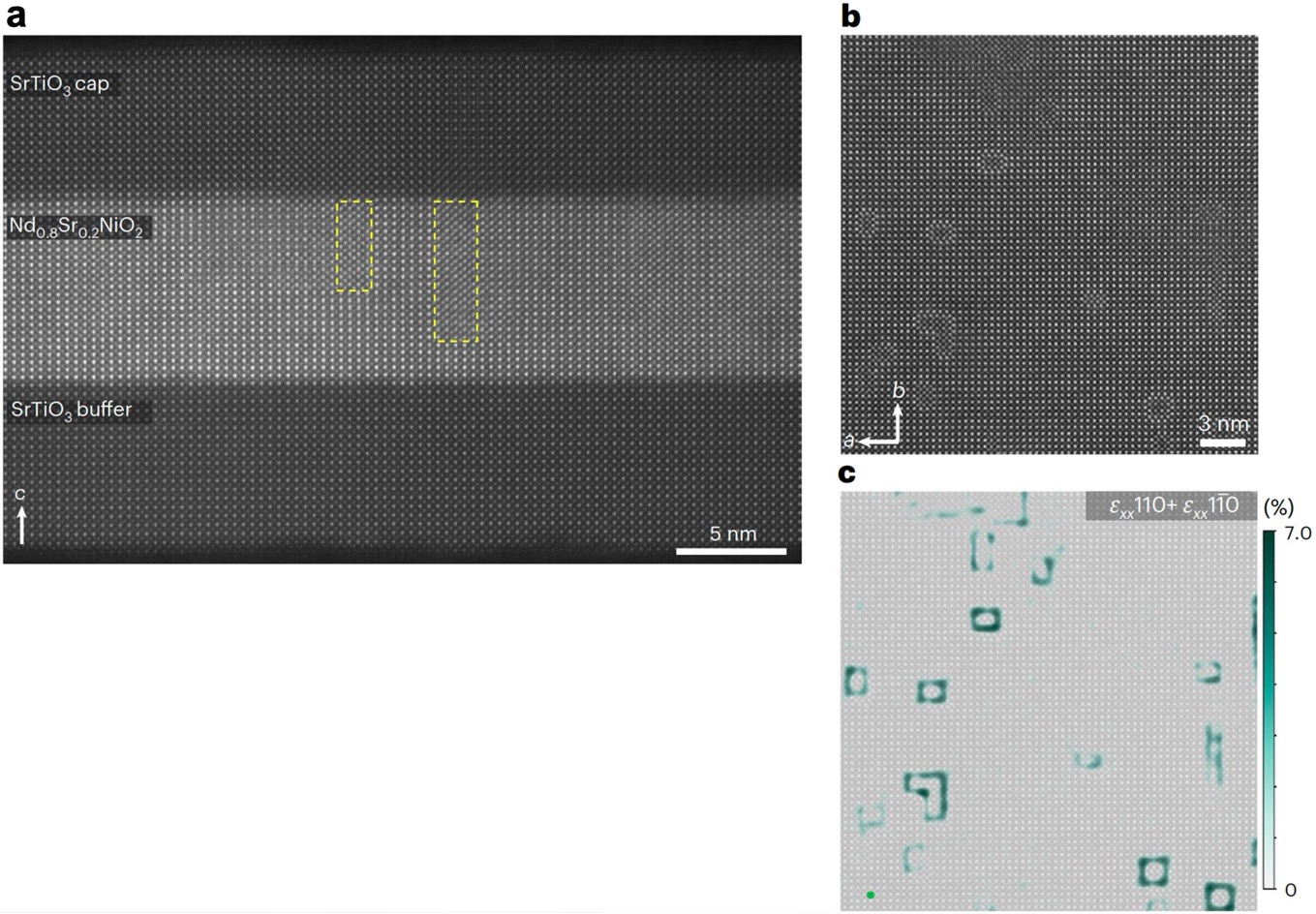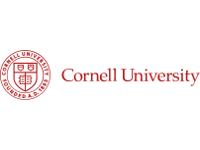PARADIM Highlight #100—External User Project (2025)
Harold Hwang (Stanford), David Muller, and Lena Kourkoutis (PARADIM)
Refining the synthesis of nickelate superconductors is a great example of the importance of frankness in a meaningful collaboration. Harold Hwang (Stanford) discovered this exciting family of new superconductors and his fruitful collaboration with Lena Kourkoutis (PARADIM) helped to perfect them. Their latest innovation involves the preparation of free-standing membranes of superconducting nickelates, where they have been released from the underlying substrate. As superconductivity in nickelates at ambient pressure has only been observed in thin films, many questions exist regarding the role of the substrate, including the strain imparted by it. Being able to measure superconductivity in the same film before and after removal from the substrate helps to clarify the role of the substrate.

Figure 1: STEM images of a SrTiO3/Nd0.8Sr0.2NiO2/SrTiO3 superconducting heterostructure transferred onto a SiNx TEM window. a) Cross-sectional HAADF STEM image. Yellow dashed lines outline regions of Ruddlesden–Popper faults. b) Plan-view HAADF STEM image. c) Compressive strain (ε) map of the plane-view image in b, highlighting the Ruddlesden–Popper faults.
The role of electron microscopy in revealing the microstructure and defects in these nickelates led to this recent paper being dedicated to Lena Kourkoutis’ memory. Lena recognized that many synthesis groups wishing to collaborate with microscopists simply desire a “pretty picture” of structural perfection to complete their synthesis paper. Lena’s standard response was “I don’t do that; I do science.” Her hallmark of exposing and discussing defects is evident in all of her papers and underscores the value of a good collaborator being simultaneously a proponent and a critic. Her approach helps her collaborators (and the entire field) avoid the trap warned of by Richard Feynman when he said, “You must not fool yourself—and you are the easiest person to fool ....”
The development of superconductivity in infinite-layer nickelates through hole-doping relies on the controlled synthesis of Ni in a high oxidation state, followed by topotactic reduction to a very low oxidation state. So far, superconductivity has been realized only in epitaxial thin films. Here we integrate these techniques with heterostructures that include an epitaxial soluble buffer layer, enabling the release of freestanding (Nd,Sr)NiO2 heterostructures. The released heterostructures exhibit comparable structural and electronic properties to those of optimized thin films, with lateral dimensions ranging from millimetres to ~100 μm, depending on the degree of strain released with respect to the initial substrate. The changes in the superconducting transition temperature upon release of the heterostructure mirror those reported for variations in substrate and pressure, suggesting a common underlying response to strain in the infinite-layer nickelate superconductivity. These freestanding structures will facilitate a range of experimental studies without the constraints of substrates.
This work help to clarify the role of the substrate, and particularly the role of strain imposed by the substrate, on the resulting superconductivity in overlying thin films of the nickelate superconductor Nd0.8Sr0.2NiO2. As superconductivity in nickelates at ambient pressure has only been observed in thin films, many questions exist regarding the role of the substrate, including the strain imparted by it. Being able to measure superconductivity in the same film before and after removal from the substrate helps to clarify the role of the substrate and refine the synthesis conditions used to produce films with higher and sharper superconducting transition temperatures.
Collaboration is the key to closing the loop. Here, PARADIM’s superb electron microscopy capabilities, which consist most importantly of superb people in addition to equipment and the methods they have developed, provided frank and meaningful characterization of the microstructure of the superconducting Nd0.8Sr0.2NiO2 thin films. This feedback helped reveal the defects in the films, both to the growers of the films and through publication to the entire community.
The work is based on a collaboration of members of the PARADIM In-House Research Team with external collaborators.
Y. Lee, X. Wei, Y. Yu, L. Bhatt, K. Lee, B.H. Goodge, S.P. Harvey, B.Y. Wang, D.A. Muller, L.F. Kourkoutis, W.-S. Lee, S. Raghu, and H.Y. Hwang, "Synthesis of Superconducting Freestanding Infinite-Layer Nickelate Heterostructures on the Millimetre Scale," available online Nat. Synth. (2025).
We acknowledge D. Li and V. Harbola for their contributions to the initial stage of this work, W. J. Kim, E. K. Ko and A. Vailionis for assistance with RSM measurements, and E. K. Ko, J. Fowlie, K. J. Crust and J. Wang for critical reading of the manuscript. This work was supported by the US Department of Energy, Office of Basic Energy Sciences, Division of Materials Sciences and Engineering (contract no. DE-AC02-76SF00515) and the Gordon and Betty Moore Foundation’s Emergent Phenomena in Quantum Systems Initiative (grant no. GBMF9072, synthesis equipment). Electron microscopy by L.B., B.H.G., D.A.M. and L.F.K. was supported by Platform for the Accelerated Realization, Analysis and Discovery of Interface Materials (PARADIM) through NSF DMR-2039380 with additional support by the Department of Defense Air Force Office of Scientific Research (grant no. FA 9550-16-1-0305) and the Packard Foundation. This work made use of a Helios focused ion beam set-up supported by the NSF (grant no. DMR-1539918) and the Cornell Center for Materials Research Shared Facilities, which are supported through the NSF MRSEC programme (grant no. DMR-1719875). The Thermo Fisher Spectra 300 X-CFEG system was acquired with support from PARADIM, an NSF MIP (no. DMR-2039380) and Cornell University. The FEI Titan Themis was acquired through NSF-MRI-1429155, with additional support from Cornell University, the Weill Institute and the Kavli Institute at Cornell.
This work is dedicated to L.F.K., who passed away on 24 June 2023.







